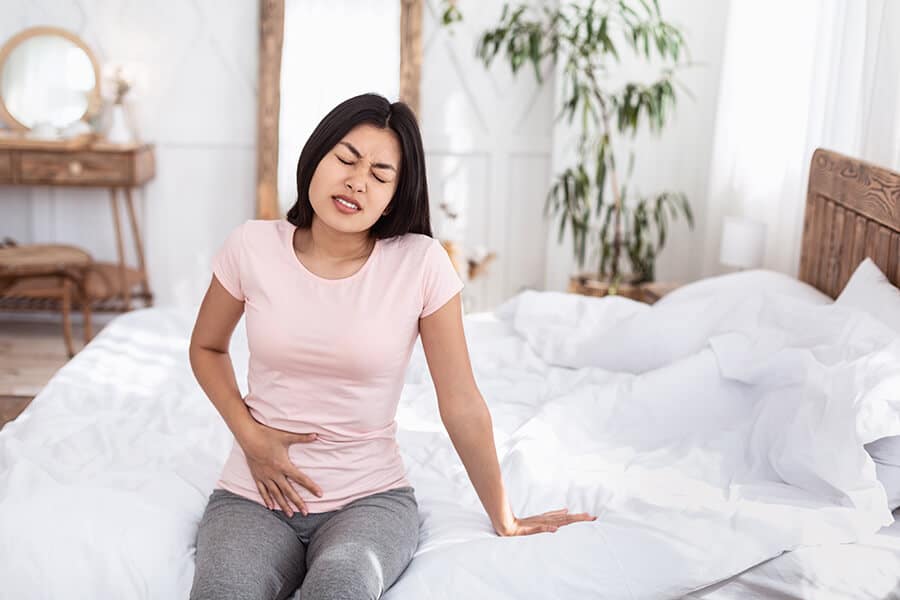What is Pelvic Cramping?
Pelvic cramping refers to a feeling of pain or discomfort in the lower abdomen. It can range from mild, intermittent aches to severe, debilitating pain. Pelvic cramping is a common experience for many people, and there are a variety of potential causes. Understanding the underlying reason for your pelvic cramps is essential to finding appropriate treatment and relief.

Common Causes of Pelvic Cramping
- Menstrual Cramps: Menstrual cramps, also known as dysmenorrhea, are one of the most common causes of pelvic pain. They occur due to the contractions of the uterus as it sheds its lining during menstruation.
- Ovulation Pain (Mittelschmerz): Some people experience a brief period of pelvic pain or cramping around the time of ovulation, typically midway through their menstrual cycle.
- Gastrointestinal Issues: Conditions like constipation, irritable bowel syndrome (IBS), and food intolerances can lead to pelvic cramping due to bloating, gas, or inflammation in the digestive tract.
- Endometriosis: This condition occurs when tissue similar to the uterine lining grows outside the uterus. It can cause painful periods, chronic pelvic pain, and other symptoms.
- Pelvic Inflammatory Disease (PID): PID is an infection of the reproductive organs that can cause severe pelvic cramping, fever, and abnormal discharge.
Pelvic Cramping and Fibroids
Uterine fibroids, noncancerous growths in the uterus, can sometimes cause pelvic cramping. The cramping may be caused by the fibroids themselves pressing on nearby organs or by the uterus contracting to expel blood clots that can form around the fibroids. The location and size of the fibroids can influence the type of cramping experienced. If you have fibroids and are experiencing pelvic cramping, it’s crucial to discuss this with your doctor to determine if the fibroids are the cause and explore treatment options.
When to See a Doctor
While pelvic cramping is often due to common and manageable causes, it’s important to see a doctor for evaluation if you experience any of the following:
- Severe or debilitating pain
- Pain that persists for more than a few days
- Pain accompanied by fever, nausea, or vomiting
- Abnormal vaginal bleeding or discharge
- Difficulty urinating or changes in bowel habits
Diagnosing the Cause of Pelvic Cramping
To determine the root cause of your pelvic cramping, your doctor will likely take a thorough medical history, perform a pelvic exam, and may order additional tests, such as:
- Ultrasound: Used to visualize the pelvic organs and look for abnormalities.
- Blood or urine tests: These can check for infection, hormone imbalances, or other underlying conditions.
- Laparoscopy: A minimally invasive surgical procedure that allows for direct visualization of the pelvic organs.
Treatment for Pelvic Cramping
Treatment for pelvic cramping depends entirely on the underlying cause. Some possible treatment options include:
- Pain Medication: Over-the-counter pain relievers like ibuprofen or naproxen can help manage mild to moderate pain from cramps or other causes.
- Hormonal Birth Control: These medications can help regulate menstrual cycles and reduce cramping for those with menstrual-related pain.
- Antibiotics: Required for infections like PID or UTIs.
- Lifestyle Changes: Managing stress, eating a healthy diet, and regular exercise can help alleviate cramping caused by digestive issues or stress.
- Surgery: In some cases, such as with severe endometriosis or large fibroids, a minimally invasive treatment or possibly surgery may be necessary to remove the problematic tissue and provide relief.
Schedule an Appointment with Preferred Fibroid
Don’t let pelvic cramping disrupt your life. If you’re experiencing pelvic pain and suspect fibroids may be the culprit, schedule an appointment with Preferred Fibroid today. Our team of qualified healthcare professionals can help diagnose the cause of your cramping and explore treatment options, including minimally invasive procedures like Uterine Fibroid Embolization (UFE) to address fibroids and alleviate your symptoms. Take control of your well-being and contact Preferred Fibroid to schedule a consultation.
